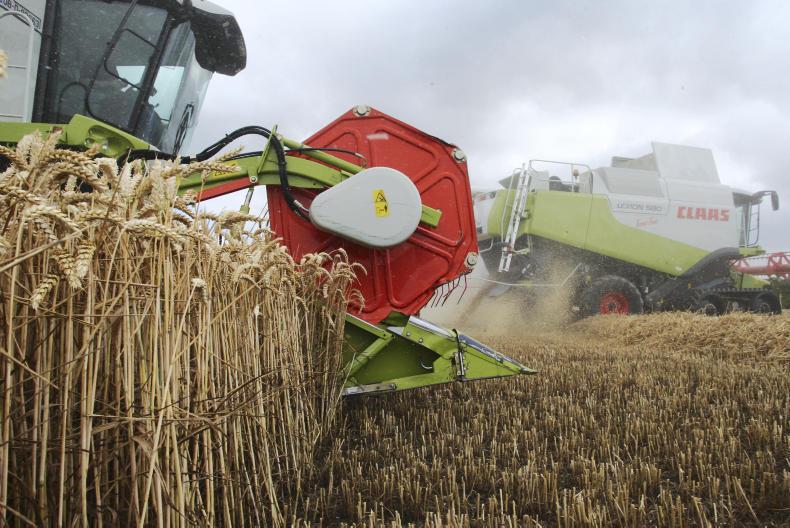The Central Statistics Office (CSO) has release its provisional estimates of 2019 land utilisation, which reports that the area sown under cereals has decreased by 16,600ha (6.4%) to 245,000ha when compared with June 2018.
The results for crops are based on data obtained from the DAFM Basic Payment Scheme (BPS).
The decrease was mainly due to a decrease of 35,500 ha (27.9%) in the area under spring barley.
The area under barley fell by 18,700ha (10.1%) and the area under wheat fell by 2,300ha (4%).
Meanwhile, the area under oats rose by 4,200ha (23.7%).
This rise was primarily driven by an increase of 5,100ha (49.7%) in the area under winter oats.
Grain growers need a strong price
Speaking at the Ploughing Championships, IFA president Joe Healy called on grain merchants, co-ops and compound feed mills to support tillage growers with a strong grain price this harvest.
“While it is positive that the decline in the cereal area has stabilised, it is still the second-lowest planted area on record, with a 20% reduction since 2012.
Irish imports of GM maize have increased from 450,000t in 2012 to over 1.5m tonnes in 2018
"In order to restore confidence in tillage farming, the trade must pay sustainable prices,” he said.
According to CSO figures, Irish imports of GM maize have increased from 450,000t in 2012 to over 1.5m tonnes in 2018, explained IFA grain chair Mark Browne.
“Substituting imports for Irish native grains leads to the loss of millions to the rural economy and also undermines Ireland’s credentials in relation to Origin Green and our carbon footprint,” he continued.
Browne concluded by saying that quality-assured Irish grain must trade at a premium and its value cannot continue to be dictated by feed ingredients, such as palm kernel from Malaysia or GM maize from Brazil, which do not conform to the regulatory and environmental standards demanded by the EU Commission and the Government.
Read more
Listen: last chance to win MF tractor at the National Ploughing Championships
Quinns releases all-Irish cereal-based rations
The Central Statistics Office (CSO) has release its provisional estimates of 2019 land utilisation, which reports that the area sown under cereals has decreased by 16,600ha (6.4%) to 245,000ha when compared with June 2018.
The results for crops are based on data obtained from the DAFM Basic Payment Scheme (BPS).
The decrease was mainly due to a decrease of 35,500 ha (27.9%) in the area under spring barley.
The area under barley fell by 18,700ha (10.1%) and the area under wheat fell by 2,300ha (4%).
Meanwhile, the area under oats rose by 4,200ha (23.7%).
This rise was primarily driven by an increase of 5,100ha (49.7%) in the area under winter oats.
Grain growers need a strong price
Speaking at the Ploughing Championships, IFA president Joe Healy called on grain merchants, co-ops and compound feed mills to support tillage growers with a strong grain price this harvest.
“While it is positive that the decline in the cereal area has stabilised, it is still the second-lowest planted area on record, with a 20% reduction since 2012.
Irish imports of GM maize have increased from 450,000t in 2012 to over 1.5m tonnes in 2018
"In order to restore confidence in tillage farming, the trade must pay sustainable prices,” he said.
According to CSO figures, Irish imports of GM maize have increased from 450,000t in 2012 to over 1.5m tonnes in 2018, explained IFA grain chair Mark Browne.
“Substituting imports for Irish native grains leads to the loss of millions to the rural economy and also undermines Ireland’s credentials in relation to Origin Green and our carbon footprint,” he continued.
Browne concluded by saying that quality-assured Irish grain must trade at a premium and its value cannot continue to be dictated by feed ingredients, such as palm kernel from Malaysia or GM maize from Brazil, which do not conform to the regulatory and environmental standards demanded by the EU Commission and the Government.
Read more
Listen: last chance to win MF tractor at the National Ploughing Championships
Quinns releases all-Irish cereal-based rations






 This is a subscriber-only article
This is a subscriber-only article










SHARING OPTIONS: